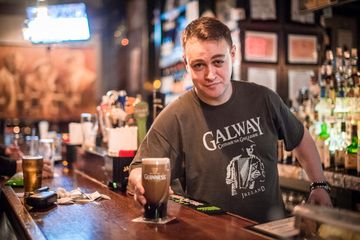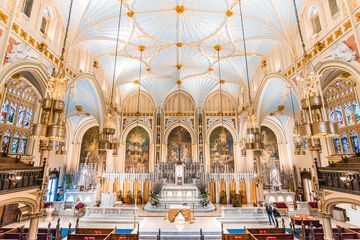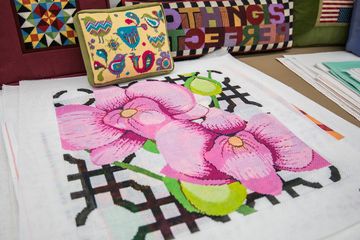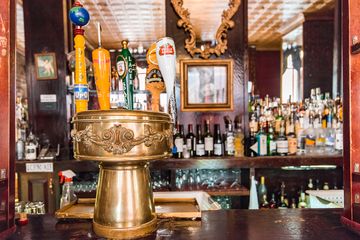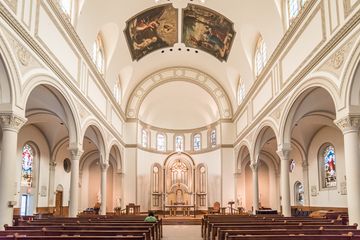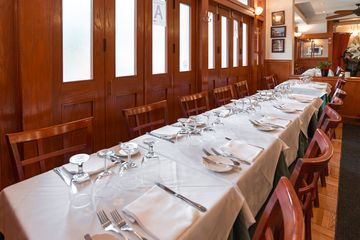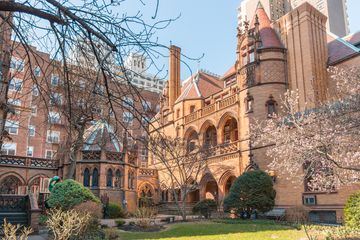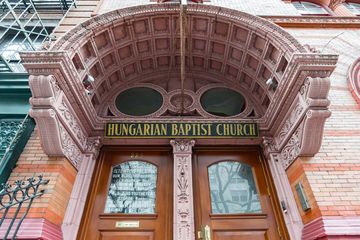Some businesses fascinate me because of their history, while others inspire me because of the unique work that they do or the niche they fill in society. Nica Trattoria captured my immediate attention due to the infectious spirit and big personality of Giuseppe Nicolosi. He wears many hats at Nica Trattoria as he is the owner, chef, waiter, and host extraordinaire. Though the restaurant is named after his partner, Dominique "Nica" Liana Russo, whom he met while she was studying at Columbia University and he was working on the Upper West Side, it is Giuseppe who greets every guest who walks through the restaurant's door. Along with referencing his partner, "Nica" means "small" in the Sicilian dialect, a perfect descriptor for a trattoria that seats about thirty guests. Giuseppe says that the name has allowed them to "with one stone, kill two pigeons. "Though Giuseppe is Sicilian, he designed the menu to be a "big hug to all of Italy. " This was not difficult, since Sicilian cuisine combines many different flavors, thanks to its diverse past. Giuseppe explained that before "Sicily annexed Italy" in 1896, it was home to a variety of cultures, causing there to be eleven distinct styles of cooking on the small island, including French, Moroccan, and Spanish. Giuseppe is proud of the number of Sicilian dishes on the menu, calling the culturally diverse taste combinations "an explosion on your palate. "Our conversation was interrupted when two families walked in to be seated for dinner. Giuseppe sprang into action, hugging the family that he knew well, clapping his hands, and addressing the entire room as "belli, " "bella, " and "bello. " One diner, who had clearly eaten at Nica Trattoria many times before, took out pictures of her children to show Giuseppe. He then proceeded to lower the lights for them and put on some light Italian classical music. He addressed both families at the same time by clinking a glass with a knife and opening the menu with a flourish and a whistle. It was like watching a thespian at work: Giuseppe creatively described the specials that included cauliflower tortino, French mussels, and fresh fava beans sauteed with sausage, while draping himself on people's shoulders and engaging in amusing conversation. The specialty of the house is the "Clouds from the sky. " When Giuseppe asked his audience if anyone knew what "Clouds from the sky" were, a well-seasoned young boy yelled out, "Gnocchi! " Giuseppe beamed and nodded, adding, "We need to put a seatbelt on you; they are so white and fluffy! " Giuseppe continued describing other dishes (like his grandma's style lasagna and buchetini with pine nuts and raisins) while waltzing around his personal stage. He then took everyone's order, his energy remaining at 100% through the entire interaction. He treated people like family, jokingly scolding them for changing their minds and declaring, "I'm coming for your order in one minute! Start to count! 60... 59... 58... "When Giuseppe returned from the kitchen, we spoke about his history. He would not reveal to Olivia, one of the Manhattan Sideways writers, exactly when he moved to New York, saying, "You wasn't born! " He preferred to focus on his mother (who taught him to cook) and the fact that he managed many restaurants in New York before opening Nica Trattoria in 2006. Giuseppe has refused to ever stop learning. He has taken countless online courses, and the wall next to the bar is riddled with his graduation certificates. He is now certified in nutrition, wine, molecular engineering, and other varied subjects. He admitted that when I walked into the restaurant, he had been taking a practice test for his newest endeavor. He confessed that he is always thinking, "How can I improve myself? "Giuseppe is extremely pleased with the reception that Nica Trattoria has received. He has many regular customers that consistently come from places outside of the city, as well as from around the world. He joked, "When an airplane lands, at least one person is thinking of Nica. " At this point, Angelo DiGangi, founder of the Community Advocacy Center and a regular at Nica, walked in and sat at his usual table. He turned to Giuseppe, not knowing I was there, and said, "This is the best spot in New York. " After I introduced myself, he said, "It's really a little bit of Sicily. " Giuseppe beamed at the compliment and moved behind the bar, agreeing that he likes to promote the Sicilian way of life, especially when it comes to the wine. He stocks a lot of Sicilian wine and is very interested in food pairings. He then pointed out that since Italy has 4, 000 years of history and the United States only 400, America has not quite had the time to figure out wine pairings. Italy is different: "Food and wine. That is Sicily. "I continued speaking with Angelo, who gushed about Giuseppe. "He does it with love, " he said, referring to both the food and the service. We had already witnessed the service, but it was clear that Giuseppe also gives his all when it comes to the food. Everything is purchased fresh each day. Angelo said that he started coming to Nica Trattoria after work for an espresso. "I fell in love with the man, " he smiled. And as Manhattan Sideways witnessed, it was hard not to fall in love with Giuseppe. Everyone gets the personal attention of a family member. As Tom, our photographer, put it dreamily, "I feel like I'm at home. "

